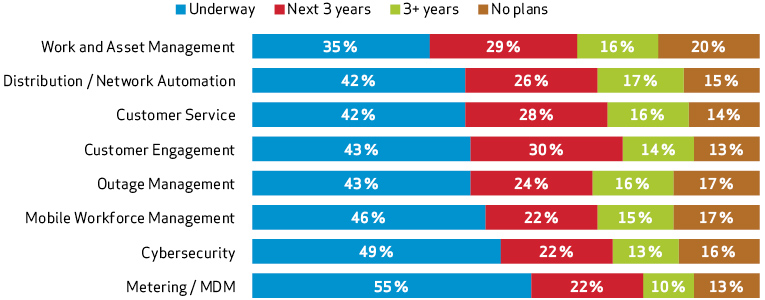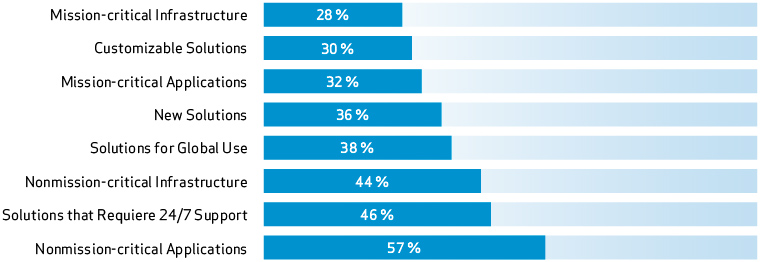The electric industry is changing, and utilities will have to adapt to the new conditions of the industry if they want to remain self-sustainable. The decline in electricity consumption in developed countries is affecting the revenue of utilities and pushing them more than ever to reduce operating and capital costs in order to keep profits stable. There is also a world-wide trend to deregulate the electricity market and democratize it. Not only will this create more competition on the generation side, but it will also exponentially increase the complexity of the grid, and therefore, the costs related to its operation and maintenance. A previous article of this series, published in the Third Quarter issue of EET&D, showed how emerging technologies like the Industrial Internet of Things (IIoT), Artificial Intelligence (AI), machine learning, cloud computing etc., can provide the tools utilities need to adapt to this new industry environment. The article also provided arguments in favor of full adoption of these technologies by the electric industry[1]. These emerging technologies are part of what now is known as the fourth industrial revolution, or Industry 4.0, which is why some people refer to the use of these technologies in the electric industry as Energy 4.0.
Despite the potential benefits of emerging technologies, there are some very important issues regarding their implementation that must be addressed before they can be adopted massively within this industry. Issues like cybersecurity, service availability and reliability, are among the common concerns raised by operations and information technology stakeholders in utilities. These issues get amplified due to existing regulations (e.g., NERC-CIP) and the lack of standards for these new technologies.
These technologies suggest a framework that allows the adoption of novel products or solutions while minimizing or eliminating the risks of disobeying regulations or negatively impacting operations. This article addresses how electric companies are implementing them.
Leading the way
Although it may seem like navigating uncharted territory when it comes to implementing Energy 4.0 technologies, the reality is that there are already several important utilities leading their implementation in the electric sector, and whose example can guide the adoption of such technologies by other electric companies.

Figure 1. North America's IIoT planned uses by area 2016 [2]
IIoT
Some companies are already leveraging the power of IIoT to reduce their operating and maintenance costs and to improve their service reliability. Figure 1 shows how utilities in North America are using or planning to use IIoT in their operations.
One example is Duke Energy, which is among the biggest electric companies in the USA. Duke Energy relied on manual data collection to monitor the condition of their assets in the field. With 60,000 data collections a month, its maintenance team spent 80 percent of their time on the road collecting data, and only 20 percent of the time analyzing it, leading to high maintenance costs and inconsistent asset condition assessment. To improve this situation, Duke developed a system that would enable the remote monitoring of 10,000 of its assets. Although the system required a significant investment to deploy 30,000 sensors all around Duke’s grid, in a lapse of four years, it helped to avoid costs of 130 percent associated with failures[3].
For communications, Duke Energy used mostly existing infrastructure. However, an electric company in North Dakota, Dakota Valley Electric Cooperative, did not have an existing communication infrastructure they could use for improving its metering system. To overcome this situation, Dakota Valley worked with a national cellphone service provider to gather the data from the 9300 smart meters deployed in their area[4], which resulted in millions of dollars in savings and a shorter project timeframe.
Cloud Computing
For many utilities, the mere idea of using cloud computing is taboo. This is understandable given the emphasis that regulating bodies have made on cybersecurity and the potential threats involved in connecting to out of premise servers through the Internet. However, those concerns did not stop ENEL, one of the biggest electric companies in the world, with assets in Europe and Latin America, and PG&E, one of the main utilities in the USA, to move their data storage and IT operations to the cloud. For both companies, the benefits of such a move completely outweighed the difficulties of implementing this new technology.
The two companies invested in completing a due process of selection and verification for the cloud providers, as well as planning and testing the implementation of the solutions. Besides the cybersecurity standards required for the network connection and data storage, ENEL, in particular, had to meet strict regulations regarding the geographic location of the data that was transferred to the cloud as well as data privacy laws. However, both companies found cloud service providers that met all their requirements for cybersecurity and storage regulations.
The results of investing in this transition were worth it. After the migration, ENEL’s system reliability reached 99.9 percent, using security policies and practices that were more sophisticated than those traditionally adopted for on-premise data centers. They also increased their capability to scale operations at minimum cost and decreased the time required for full provisioning from three-to-four weeks to only two days. All these improvements were done while achieving savings of up to 60 percent in storage costs, and 20 percent in computational power across the entire organization[5].

Figure 2. Framework for a successful implementation of new technologies by electric companies.
For PG&E, the migration to the cloud helps them to adapt their operations to the rapid increase of distributed energy resources (DER) in northern California, a product of the government regulations toward climate change. The tools available on the cloud also allows them to lower their operating costs while creating new business opportunities in a disruptive market where customers are already generating their own power[6].
The previous examples show that utilities are not against innovation. On the contrary, whenever the benefits outweigh the costs, the changes that enable the adoption of new technologies will be undertaken.
A framework for the implementation of new technologies
Based on the examples provided, we could summarize a series of basic steps, or framework, for the adoption of emerging technologies (Figure 2), which applies to both pilot projects or a company-wide implementation:
1. Identify the problem
Always start with the problem, which must be properly defined and understood. If there is nothing to solve or fix, then there is no reason to implement a “solution”, no matter how novel or attractive the technology is.
Once the problem has been defined, identify the systems and assets that are impacted by it and how critical they are in the operations and reliability of the grid. This step will reveal the stakeholders that are directly affected by the problem, and that must be involved from the beginning in order to get their input and eventually turn them into champions of the solution in their respective teams or departments.
Do not commit to any specific solution yet, and do not involve any more actors than the ones affected directly by the problem. Committing to a solution at this point will block the possibility of finding a better one. At the same time, the more people involved in the decision-making process, the harder it will be to assimilate all inputs and requirements, and therefore, to make decisions and advance.
2. Generate options
Identify as many alternative solutions for the problem as possible. Make sure to map the systems and assets each of these solutions affect, and the additional stakeholders they will bring to the decision-making process. Then, list the pros and cons for each of them and select the top three solutions where the pros exceed the cons. If a new technology that was being considered is not among the top three finalists, it is not meant to solve this specific problem and should not be implemented for it.
3. Assess and minimize the risk
There are two types of risk that should be assessed at this point: The risk of the problem to create physical or cyber issues, if not addressed in a timely manner, and the risk of each potential solution to create similar issues when implemented. The former will provide arguments to raise resources for the implementation of a solution, while the latter will provide decision-makers with an important dimension to compare the selected solutions.
A key part of this assessment is the understanding of the impact the occurrence of any of these issues would have on the operation or reliability of the grid, as well as the likelihood of this occurrence[7]. If this step is missed or not done properly, it could overwhelm stakeholders and decision-makers with requirements that are not actually needed, on the one hand, or make the problem bigger and turn the solution into a liability, on the other hand.
When it comes to meeting regulatory compliance, like NERC CIP, it is very important to make sure the application really requires it; otherwise, it will place unnecessary roadblocks to the process, as well as an excess of time and resources to the development of the project. Figure 3 shows the results of a survey done among Chief Information Officers of different industries worldwide about the area of implementation of cloud computing and storage in their operations. From the results, we could conclude that this technology is used mostly for non-critical processes and infrastructure, which is less regulated, allowing IT teams to gain the experience needed before implementing the technology in more critical processes. Utilities can copy this model in their adoption of emerging technologies: start with the non-critical applications before moving to the critical ones.

Figure 3. Current uses of cloud computing[8]
If the application falls under a regulation, then industry standards and certifications can be used to support regulatory compliance. These can also verify the robustness and reliability of a product or technological solution toward specific implementations, and therefore, mitigate the risks associated with a solution. However, in the case of most emerging technologies, there might not be industry standards defined yet, nor proper certifications that support the reliability of such technologies. In these cases, the standards and certifications applied to existing technologies employed for similar purposes as particular areas of the new product or technology can be used as a reference. For example, the standards IEC61850-3 and IEEE1613 can help to assess the level of physical reliability of IoT devices in a substation environment, while the standards IEC62351 and IEEE1686-2007 can guide the same process regarding the cybersecurity protection of the communication and the cloud platform.
It is important to understand the purpose of each part of the standards, as chances are that the new technology will not meet them all; however, the ones met might be enough to minimize the risk to a level acceptable for the stakeholders.
4. Test the solutions
Create an experiment in a controlled environment that can demonstrate the capabilities. The experiment must have deadlines, as well as a set of parameters and goals to measure the success of a product or technology in solving the problem defined in step one. These deadlines, parameters and goals must be as clear and specific as possible, to avoid confusion among decision-makers.
5. Promote the best product or solution
The product or technology selected must be promoted throughout all areas of the company before and during its implementation. A survey completed in 2017 among several utilities in the USA revealed that internal resistance to change is one of the top five obstacles for the evolution of business models and technologies in the electric industry[9]. Therefore, championing the new technology within the company is crucial for successful implementation. PG&E is a good example of how this is done. A mentorship program was created within the company to train anyone interested in the new technology that was being implemented. Their goal was to enroll at least 10 percent of the company’s workforce in this program in order to meet a tipping point in favor of the new technology. They were able to enroll 15 percent of the workforce and create a culture within the company that guaranteed the success of the adoption of such solution[6].
Conclusion
The implementation of new technologies does not have to be a leap of faith for electric companies. Some utilities have taken the lead and shown the industry that innovation can be done while minimizing the risk to assets and operations. The process followed by these companies, and other industry innovators, was summarized in a framework that can serve as a guide for the successful adoption of new technologies in electric companies. The sooner utilities start adopting these new technologies; the easier and safer it will be for their adaptation to the changing environments of the electric industry.

Richard Harada has more than 20 years of experience in industrial networking communications and applications. Prior to joining Systems With Intelligence, Harada worked at RuggedCom and Siemens Canada, where he focused on product management and business development for industrial communications in the electric power market. Harada is an electronic engineering technologist and has a Bachelor of Science degree in computer science from York University in Toronto.

Edgar Sotter has a doctorate in electronic engineering from Universidad Rovira I Virgili (Spain), an MBA from University of Toronto (Canada) and a Bachelor of Science in electrical engineering from Universidad del Norte (Colombia). Sotter’s fields of expertise are in sensors, monitoring systems and computer networks. Sotter has experience working at Siemens/RuggedCom, and he is currently the director of product strategies & client services at Systems With Intelligence.
References
[1] E. Sotter, "Energy 4.0, Revolution or Fad?," ELECTRIC ENERGY T&D MAGAZINE, vol. 22, no. 3, pp. 26-31, 2019.
[2] SAS Institute; Zpryme Research & Consulting, Planned uses of Internet of Things (IoT) in utilities in North America in 2016, by area, The Autonomous Grid: Machine Learning and IoT for Utilities, page 6, 2016. .
[3] A. West, "Duke Energy Leverages IIoT for Predictive Maintenance Applications," 01 2018. [Online]. Available: https://www.insight.tech/industry/duke-energy-leverages-iiot-for-predictive-maintenance-applications. [Accessed 23 08 2019].
[4] Verizon, "Dakota Valley Electric Cooperative combines traditional service values with a modern grid," 2017. [Online]. Available: https://16966c0d02ae8ddc176e-a393fe9355878ef10df79e27f1add196.ssl.cf5.rackcdn.com/files/case_studies/10808573_Dakota_Valley_Written_CS_f1a_sb.pdf. [Accessed 23 08 2019].
[5] R. Bigliani, "Enel Embraces AWS Cloud to Transform its IT," 09 2016. [Online]. Available: https://d0.awsstatic.com/analyst-reports/ENEL%20AWS%20Case%20Study%20English.pdf. [Accessed 23 08 2019].
[6] Amazon Web Services, "Pacific Gas & Electric Company Case Study," 2017. [Online]. Available: https://aws.amazon.com/solutions/case-studies/pacific-gas-electric/. [Accessed 23 08 2019].
[7] D. Christensen, M. Martin, E. Gantumur and B. Mendrick, "Risk Assessment at the Edge: Applying NERC CIP to Aggregated Grid-Edge Resources," The Electricity Journal, no. 32, pp. 50-57, 2019.
[8] C. Brown, "The State of Cloud Adoption," 11 11 2018. [Online]. Available: https://deloitte.wsj.com/cio/2018/11/11/the-state-of-cloud-adoption/. [Accessed 28 08 2019].
[9] Utility Dive, "What is the greatest obstacle to the evolution of your utility's business model?", 2018 State of the Electric Utility Survey Report, page 65, 2018.







